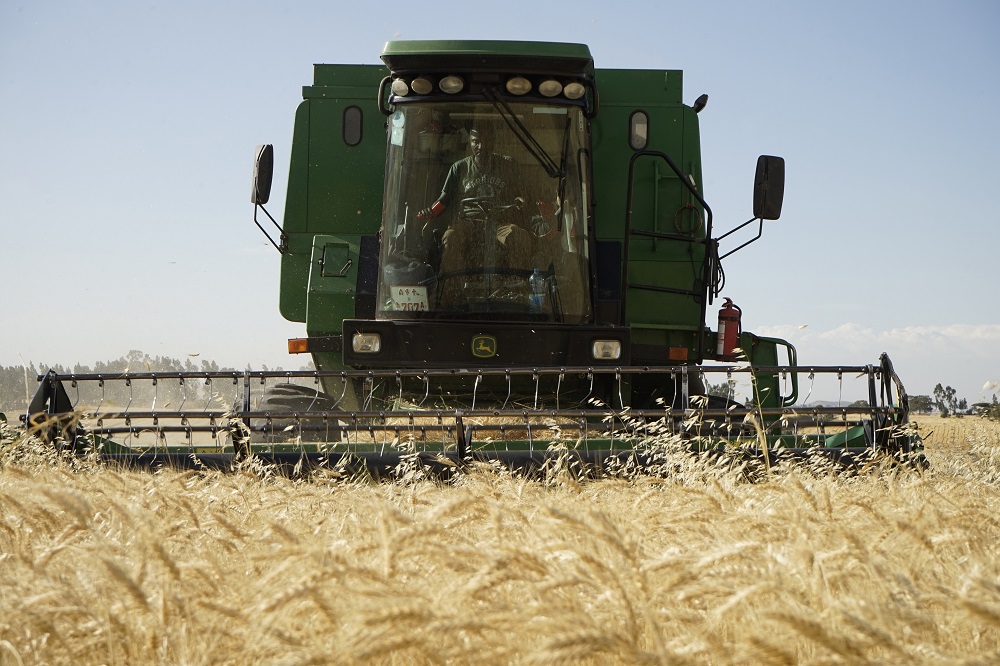
KIGALI, Rwanda (CIMMYT) – The recent designation of wheat as a strategic crop for Africa by the African Union in 2013 reflects the rising importance of wheat production on the continent. Since then, efforts have intensified to incorporate wheat production into existing farm systems and to help smallholders grow it to meet rising demand and reduce the economic impact of the high cost of imports.
The International Maize and Wheat Improvement Center (CIMMYT) is contributing to these efforts through a project launched this month in Kigali, Rwanda. The four-year Enhancing Smallholder Wheat Productivity through Sustainable Intensification of Wheat-based Farming Systems in Rwanda and Zambia (SWPSI) project aims to enhance the potential of wheat produced by smallholder farmers to bolster food security.
“Given the increasing opportunities in wheat research, CIMMYT is happy to work with partners to help farmers adopt improved technologies, establish innovation platforms and strengthen wheat value chains in the two countries,” said Bekele Abeyo, Ethiopia country representative and wheat breeder at CIMMYT.
Zambia and Rwanda rank 46th and 59th respectively in the list of wheat-producing nations, topped by China. Production in Zambia, where wheat grows on more than 40,000 hectares (99,000 acres), is largely undertaken by medium and largescale commercial operations in irrigated conditions with very little smallholder production. On the other hand, in Rwanda wheat is grown on about 35,000 hectares in rainfed conditions mainly by smallholder farmers.
“The contrast between the two countries will help generate wider lessons on variations and give an opportunity to test whether wheat is still a potential crop to produce profitably under smallholder systems,” said Moti Jaleta, CIMMYT SWPSI project leader.
The new project will target 4,000 smallholder farmers in the two countries, with a focus on increasing wheat productivity from the current 2.1 tons per hectare to an average of 4.5 tons per hectare.
Smallholders will also benefit from improved technologies, which include rust-resistant and high-yielding wheat varieties, such good agronomic practices as row planting, precise fertilizer application, plant density and planting dates. Additionally, threshing technologies to enhance grain quality and efforts to link farmers with established traders and millers to help them secure markets for their wheat surplus will be undertaken.
The project mandate includes a scoping study on the potential for smallholder wheat production in Madagascar, Mozambique and Tanzania.
Funded by the International Fund for Agricultural Development and the consortium of agricultural researchers, the CGIAR Research Program on WHEAT, SWPSI will be implemented under the leadership of CIMMYT in close collaboration with the Center for Coordination of Agricultural Research and Development for Southern Africa (CCARDESA), the Rwanda Agriculture Board and the Zambia Agricultural Research Institute.
Speaking during the launch, the acting executive director of CCARDESA, Simon Mwale, noted the rising demand for wheat, particularly in southern Africa, which also has a very conducive climate for wheat farming.
“Inclusion of Rwanda in the project is a unique opportunity for CCARDESA, and it will facilitate strong collaboration and new learning opportunities, being a new country to be covered by CCARDESA,” he said.
Experts hope SWPSI will contribute to the broader focus of the strategy to promote African wheat production and markets.
Some 30 key stakeholders met at a side event organized by CIMMYT at the recent 7th Africa Agricultural Science Week (AASW) to discuss how best to implement the region’s wheat strategy. The AASW and FARA General Assembly is the principal forum for all stakeholders in African agriculture science, technology and innovation to share solutions to some of the most pressing challenges the continent faces. CIMMYT’s SWPSI project is key to supporting the wheat for Africa strategy whose goal is to increase agricultural productivity and food security throughout the region.
 Capacity development
Capacity development 
